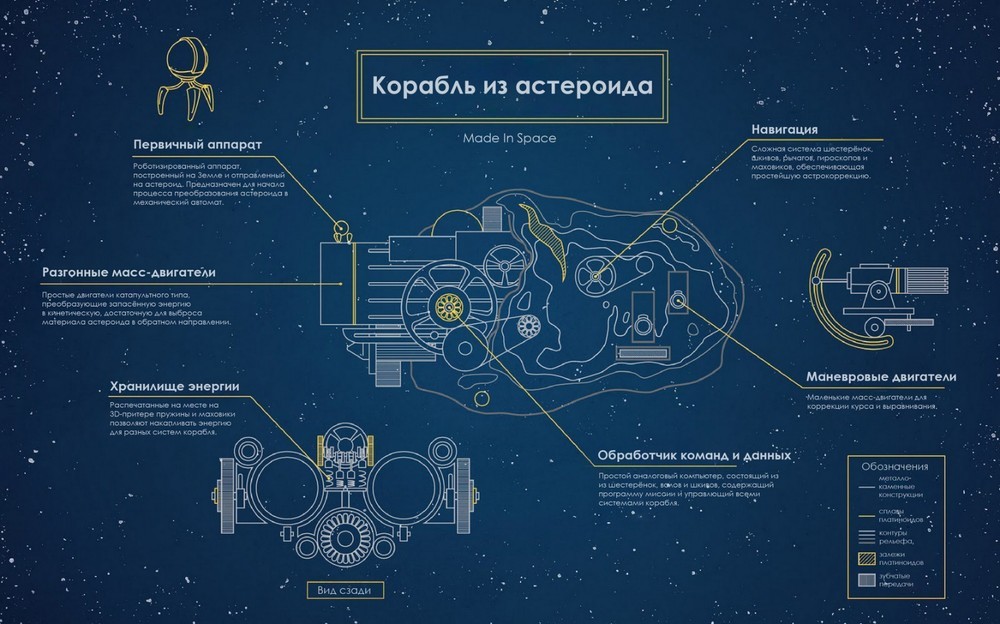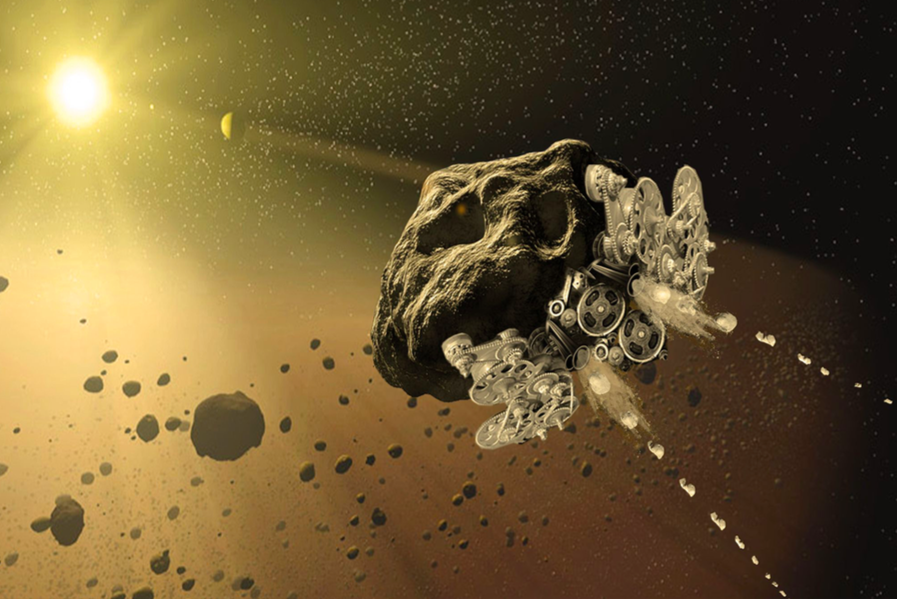Asteroid spaceship

It's funny that even in the space industry, not every day you manage to work on really large-scale ideas. In Made In Space, the lion’s share of our engineering energy is spent on developing concepts that will be turned into real-life equipment within five years. We like to talk a lot about the future, draw types of space colonies on boards, or discuss what production difficulties can be at Enceladus. Although we usually do not work on long-term projects, but thanks to the NIAC program we will still be able to participate in something similar.
As part of NASA's Innovative Advanced Concepts (NIAC, Innovative NASA Advanced Concepts ) research grants are provided to explore various non-standard ways of exploring space. The focus is on fairly long-term projects implemented in 10 years or more. We at Made In Space recently proposed a new vision for the exploration and use of asteroids, and for this we received a grant from NIAC. That is our offer.
For the past few decades, mission ideas have been considered, in which far-space bases would be used at libration points and in circumlunar orbit.
')
In 1974, Gerard O'Neil proposed building a space colony with production facilities at the Earth-Moon libration point L5. Representatives of the "Society L5" (L5 Society) described the satellite systems for collecting solar energy, located at the points of libration and intended to save electricity generation on Earth. Soon NASA proposed the ARM program ( Asteroid Redirect Mission ), within which the concept of safe transportation of a multi-ton asteroid to the lunar orbit with the help of robotic ships was worked out. At the destination, an astronaut team would have to collect an unprecedented number of samples for further study on Earth.
All these ideas are as exciting as they are diverse.
In this case, the described scenarios are united by one thing - the need of a space base for building materials .
This problem was proposed to be solved in various ways. For example, experts working on ARM offered to transport an asteroid using a solar-powered tug. And O'Neill promoted the idea of transporting the necessary materials from the surface of the moon.
We at Made In Space offer a different way to deliver materials . It is easily scalable, cost effective, and automatically allows abundantly supply any place in the solar system with resources. We are developing the RAMA architecture, thanks to which the asteroid can be turned into a primitive spacecraft capable of moving independently to the desired point in space.
The abbreviation RAMA stands for Reconstituting Asteroids into Mechanical Automata (Conversion of an asteroid into a mechanical automaton) . Our project assumes the use of the advantages of additive production and the use of resources on-site, at the in-situ resource utilization (ISRU). This will achieve the highest efficiency of asteroid redirection missions.
In other words, we are exploring the possibility of turning asteroids into autonomous powered spacecraft.
Mission worth exploring
A key aspect of the NIAC program is that the proposed concepts should be described in the context of a mission. We have many different ideas for using the RAMA architecture, but most of all we like this:
In the late 2030s, the Primary Vehicle was launched from Earth, which, using an electric power plant and gravitational forces, is sent to intercept an asteroid flying at a distance not more than 10 times the distance from the Earth to the Moon.
After a successful meeting with the asteroid, using ISRU technology developed in NASA, the Primary Apparatus begins to extract materials from the surface and from a small depth of a celestial body.
These materials are used to create the stocks needed to produce the mechanical components of a spacecraft.

The asteroid, transformed into a giant mechanical spacecraft, is independently sent to the base for the extraction of minerals.
As components are manufactured and tested, they are built into a large, complex structure that includes mechanical subsystems for computing, maneuvering, acceleration, energy storage, and navigation.
As a result, the asteroid will turn into an autonomous mechanical free-flying spacecraft - RAMA-1. It will be programmed to slowly change its course in order to finally fly to the libration point L5, where it will be used to extract useful resources from it.
As soon as RAMA-1 starts moving towards the target, the Primary spacecraft will go to a new asteroid to turn it into RAMA-2. And so on until the Primary Apparatus fails.
What we now allocated funding
Made In Space received funds from NASA for the initial work under Phase 1. This means that over the next 9 months we will explore the feasibility of the RAMA concept.
At an early stage of work, we will concentrate on developing a mission plan, and also try to better understand how you can control an asteroid using an analog mechanism.
Our immediate goal: in 9 months to have a detailed description of the mission structure, as well as to present a list of technologies necessary for the implementation of RAMA and requiring investments (in the production and use of materials).
Why is it important to develop long-term projects?
Finding a topic for research that meets the NIAC criteria is not an easy task. In fact, this is a combination of powerful technological concepts with an admixture of science fiction.
We found inspiration in the idea of a cosmic mechanical automaton, similar to John von Neumann and Astrophysilon Freeman Dyson's Self- Replicating Machines . These technological concepts have been analyzed for decades, and there are many ideas for their implementation.
With the help of the RAMA project, we will give a new impetus to the idea of self-replicating spacecraft, given that these automata will be simple calculators and transport devices, simply enlarged to the size of an asteroid.

Antikythera mechanism . Created in about 150 BC, the oldest analog computer in the world.
How simple can get a similar machine? Our developments are based on technologies that have existed for thousands of years. The Anti-Kite mechanism is considered the world's oldest analog computer, it was created a century and a half before the advent of our era. The device made it possible to calculate the movements of stars and planets with incredible accuracy, and researchers still argue about how it could have been designed and manufactured in such ancient times.
Of course, the transformation of a whole asteroid into something like the Anti-Catheria mechanism looks fantastic. In fact, the name RAMA was inspired by Arthur Clarke’s “ A Date with Rama ”. But the cool technologies, inspired by the insane vision of the future, are created by teams ready for this grand new challenge. And for Made In Space, projects like RAMA, located on the far borders of our grocery roadmaps, are helping to achieve success in the short term.
Source: https://habr.com/ru/post/395175/
All Articles